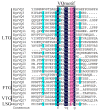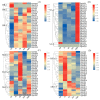Genome-Wide Characterization, Evolution, and Expression Profiling of VQ Gene Family in Response to Phytohormone Treatments and Abiotic Stress in Eucalyptus grandis
- PMID: 30974801
- PMCID: PMC6480042
- DOI: 10.3390/ijms20071765
Genome-Wide Characterization, Evolution, and Expression Profiling of VQ Gene Family in Response to Phytohormone Treatments and Abiotic Stress in Eucalyptus grandis
Abstract
VQ genes play important roles in plant development, growth, and stress responses. However, little information regarding the functions of VQ genes is available for Eucalyptus grandis. In our study, genome-wide characterization and identification of VQ genes were performed in E. grandis. Results showed that 27 VQ genes, which divided into seven sub-families (I-VII), were found, and all but two VQ genes showed no intron by gene structure and conserved motif analysis. To further identify the function of EgrVQ proteins, gene expression analyses were also developed under hormone treatments (brassinosteroids, methyl jasmonate, salicylic acid, and abscisic acid) and abiotic conditions (salt stress, cold 4 °C, and heat 42 °C). The results of a quantitative real-time PCR analysis indicated that the EgrVQs were variously expressed under different hormone treatments and abiotic stressors. Our study provides a comprehensive overview of VQ genes in E. grandis, which will be beneficial in the molecular breeding of E. grandis to promote its resistance to abiotic stressors; the results also provide a basis from which to conduct further investigation into the functions of VQ genes in E. grandis.
Keywords: Eucalyptus grandis; VQ genes family; abiotic stress; expression pattern; plant hormones.
Conflict of interest statement
The authors declare no conflict of interest.
Figures








References
-
- Pecher P., Eschen-Lippold L., Herklotz S., Kuhle K., Naumann K., Bethke G., Uhrig J., Weyhe M., Scheel D., Lee J. The Arabidopsis thaliana mitogen-activated protein kinases MPK3 and MPK6 target a subclass of ‘VQ-motif’-containing proteins to regulate immune responses. New Phytol. 2014;203:592–606. doi: 10.1111/nph.12817. - DOI - PubMed
-
- Chen Y., Zhou Y., Yang Y., Chi Y.-J., Zhou J., Chen J.-Y., Wang F., Fan B., Shi K., Zhou Y.-H. Structural and functional analysis of VQ motif-containing proteins in Arabidopsis as interacting proteins of WRKY transcription factors. Plant Physiol. 2012;159:810–825. doi: 10.1104/pp.112.196816. - DOI - PMC - PubMed
MeSH terms
Substances
Grants and funding
LinkOut - more resources
Full Text Sources

